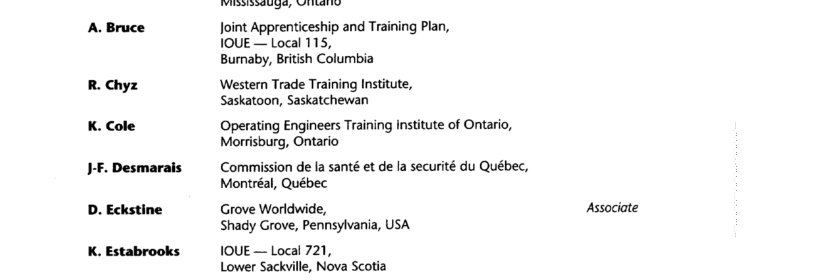CSA Z150-98 pdf download – Safety Code on Mobile Cranes.
2. Reference Publications and Definitions 2.1 Reference Publications This Standard refers to the following publications and where such reference is made it shall be to the edition listed below: CSA Standards Elevating Rolling Work Platforms; Self-Propelled Elevating Work Platforms for Use on Paved/Slab Surfaces; Self-Propelled Elevating Work Platforms for Use as “Off-Slab” Units; Boom- Type Elevating Work Platforms; Vehicle- Mounted Aerial Devices; Certification of Companies for fusion Welding of Steel Structures; Welded Steel Construction (Metal Arc Welding); Certification of Welding Inspectors; Code for Tower Cranes; Safety Belts and Lanyards; Full Body Harnesses; CAN3-B354.1 -M82, CAN 3-6354.2-M82, CAN 3-B354.3-M82, CAN 3-8354.4-M82, CAN/CSA-C225-M88, W47.1-92, W59-M1989, W178.2-96, 2248-1 975, CAN/CSA-Z259.1-95, CAN/CSA-Z259.10-M90,
Swing mechanism – the machinery involved in providing rotation of the superstructure. Swivel – a load-carrying member with thrust bearings to permit rotation under load in a plane perpendicular to the direction of the load. Swivelling -the rotation of the load attachment portion (hook or shackle) of a load block or hook assembly about its axis of suspension in relation to the load line(s). Tackle – an assembly of ropes and sheaves arranged for hoisting and lowering. Telescopic boom – a boom consisting of a base boom from which one or more boom sections are telescoped for additional length. Transit – the moving or transporting of a crane from one job site to another. Travel -the function of the machine moving from one location on a job site to another. Travel mechanism -the machinery involved in the travel. Two-blocking -the condition when the lower load block or hook assembly comes in contact with the upper load block or boom point. Two-blocking-damage preventive feature -see Anti-two-block device. Wheel base – the distance between centres of the front and rear axles. For a multiple axle assembly, the axle centre for wheel base measurement is taken as the mid-point of the assembly. Wheel- (carrier-) mounted crane – a crane consisting of a rotating superstructure, operating machinery, and operator’s station and boom, mounted on a crane carrier equipped with axles and rubber-tired wheels for travel, a power source(s), and having single or separate stations for driving and operating. Its function is to lift, lower, and swing loads at various radii. Whipline – a separate hoist-rope system other than the main hoist; also called auxiliary hoist.
3.1 Load Ratings 3.1.1 Ratings Governed by Crane Stability 3.1.1.1 In some areas of operating range, the load ratings may be governed by the stability of the crane (ie, the load required to tip the crane at a given radius) rather than by structural competence. The margin of stability for determining the load ratings, with booms of stipulated length at stipulated working radii for various types of crane mountings, is established by taking a percentage of the loads that will produce a condition of tipping or balance with the boom in the least stable direction, relative to the mounting. 3.1.1.2 Where the load ratings are governed by stability, they shall be determined in accordance with SAE Recommended Practice 1765, and they shall not exceed the percentages in Table 1 .
3.1.1.4 The actual load that can be safely lifted will be influenced by such additional factors as freely suspended loads, wind or ground conditions, condition and inflation of tires, track or tread width, boom lengths, proper operating speeds for existing conditions, and, in general, competent operation. Any standard attachments to the boom, such as jibs and auxiliary or whiplines, shall be considered as affecting stability, and a deduction shall be made from load ratings in accordance with the manufacturer’s instructions, unless the manufacturer offers separate capacity charts for operations with attachments. The effect of light fixtures, pile lead adaptors, and other nonstandard attachments shall be deducted from the load ratings. No load shall be lifted over the front area of a truck-mounted crane, except as approved by the crane manufacturers and noted on the load chart. in addition to those stipulated in Clauses 3.1.1.2 and 3.1.1.3 will influence the stability and structural competence. The load ratings for a crane on a barge or pontoon shall be modified as recommended by the manufacturer or a professional engineer. When cranes included in the scope of this CSA Standard are mounted on barges and pontoons, factors 3.1.2 Ratings Governed by Structural Competence 3.1.2.1 In some areas of the operating range, the load ratings may be governed by structural and hydraulic competence rather than crane stability. Conditions below describe operating ranges where the rating may be limited by factors other than stability: (a) The loads that will produce a condition of tipping increase rapidly and reach extreme values as the minimum operating radius and tipping fulcrum of the machine are approached. At some radii, these loads are of such magnitude that they cannot be used as rated capacity limitations without resulting in excessive weight, which would severely limit performance and ratings at the longer radii where most work is done. CSA Z150-98 pdf download.
